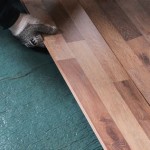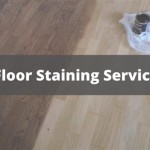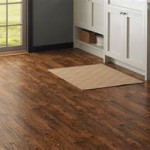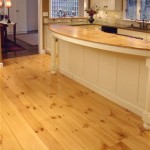How to Remove Sticky Residue From Wood Floors
Sticky residue on wood floors is a common problem that can arise from a variety of sources. Spilled food and drinks, adhesive from stickers or tape, tracked-in dirt mixed with moisture, and even certain cleaning products can leave behind an unsightly and often stubborn film. Addressing this residue is crucial not only for the aesthetic appeal of the floor but also for its long-term maintenance. If left unattended, sticky substances can attract more dirt, become ingrained in the wood's finish, and potentially damage the floor over time. Therefore, understanding the causes of the residue and employing effective removal techniques is essential for preserving the beauty and integrity of wood flooring.
The type of wood floor and its finish will significantly influence the methods and cleaning agents suitable for removing sticky residue. Wood floors are broadly categorized into two primary types: surface-sealed and penetrating oil finish. Surface-sealed floors, typically coated with polyurethane, varnish, or lacquer, offer a protective barrier against moisture and stains. These finishes are generally more resistant to water damage and can withstand a wider range of cleaning solutions. Penetrating oil finishes, on the other hand, soak into the wood grain, providing a more natural look and feel. These floors require special care and cleaning products formulated specifically for oiled wood. Using the wrong cleaning agent on an oil-finished floor can strip the finish, leading to dryness, cracking, and increased susceptibility to stains.
Before attempting any cleaning method, it is crucial to identify the type of finish on the wood floor. Consulting the manufacturer's documentation or contacting the installer can provide this information. If the finish type is unknown, performing a test on an inconspicuous area, such as inside a closet or under furniture, is recommended. Apply a small amount of the chosen cleaning solution and observe how the finish reacts. If the finish becomes dull, cloudy, or damaged, discontinue use and select a more appropriate method.
Identifying the Type of Sticky Residue
Accurately identifying the source of the sticky residue is a critical first step in determining the most effective removal strategy. Different types of substances require different approaches. For instance, residue from tape or stickers contains adhesive compounds that often respond well to solvents or heat. Food and beverage spills, particularly those containing sugar, may require enzymatic cleaners or gentle scrubbing. Tracked-in dirt and grime, mixed with oils and moisture, typically respond well to warm water and a mild detergent. By identifying the specific culprit, the appropriate cleaning solution and technique can be selected, minimizing the risk of damage to the wood floor.
One common source of sticky residue is adhesive left behind from stickers, tape, or protective films. These adhesives are designed to bond surfaces together, and removing them can be challenging. Over time, the adhesive can harden and become increasingly difficult to remove. Similarly, spills of sugary substances, such as juice, soda, or honey, can leave behind a sticky film as they dry. These substances attract dust and dirt, exacerbating the problem and creating a breeding ground for bacteria. Grease and oil spills also contribute to sticky residue, clinging to the floor's surface and attracting dirt. Identifying the nature of the spill, whether it is adhesive-based, sugary, or greasy, is essential for selecting the correct cleaning agent.
Another common culprit is the improper use of cleaning products. Some cleaning solutions can leave behind a sticky residue if they are not properly diluted or if the floor is not adequately rinsed after cleaning. Certain cleaning products contain polymers or waxes that can build up over time, creating a dull and sticky film. Additionally, using harsh chemicals or abrasive cleaners can damage the floor's finish, making it more susceptible to dirt and grime accumulation. It is essential to use cleaning products specifically formulated for wood floors and to follow the manufacturer's instructions carefully. Rinsing the floor thoroughly with clean water after cleaning can help prevent residue buildup.
Effective Cleaning Methods: A Step-by-Step Guide
Once the type of residue has been identified and the floor's finish determined, the appropriate cleaning method can be selected. Several effective techniques can be employed to remove sticky residue from wood floors, ranging from simple household solutions to specialized cleaning products. Regardless of the chosen method, it is crucial to work in small sections and to avoid excessive moisture, which can damage the wood. Always test the cleaning solution on an inconspicuous area before applying it to the entire floor.
For general sticky residue caused by food spills, dirt, or mild adhesive, warm water and a mild detergent can be effective. Begin by sweeping or vacuuming the floor thoroughly to remove any loose dirt or debris. Mix a small amount of mild dish soap with warm water, creating a solution that is gentle enough for wood floors. Dip a soft cloth or mop into the solution, ensuring it is damp but not soaking wet. Wring out any excess water to prevent pooling on the floor. Gently wipe the affected area, working in the direction of the wood grain. Rinse the cloth or mop frequently in clean water to remove any dirt or residue. After cleaning, dry the floor thoroughly with a clean, dry cloth to prevent water spots.
For more stubborn adhesive residue, such as that left by stickers or tape, several options can be considered. One effective method is to use a hairdryer to gently heat the adhesive. The heat softens the adhesive, making it easier to remove. Hold the hairdryer a few inches away from the residue and apply heat for a few seconds. Then, use a plastic scraper or a soft cloth to gently lift the adhesive from the floor. Avoid using metal scrapers, as they can scratch the finish. Another option is to use a solvent-based adhesive remover. These products are specifically designed to dissolve adhesive compounds. Apply a small amount of the adhesive remover to a clean cloth and gently blot the residue. Allow the remover to sit for a few minutes to soften the adhesive, then wipe it away with a clean cloth. Always test the adhesive remover on an inconspicuous area before applying it to the entire floor to ensure it does not damage the finish.
Vinegar, a natural acidic cleaner, can also be effective for removing sticky residue from wood floors. Mix equal parts of white vinegar and warm water in a spray bottle. Lightly mist the affected area with the solution and let it sit for a few minutes to loosen the residue. Then, wipe the area with a clean, damp cloth. Vinegar can help to dissolve sticky substances and remove grime, but it is important to use it sparingly, as excessive vinegar can damage the floor's finish. After cleaning with vinegar, rinse the floor with clean water and dry it thoroughly.
For floors with a penetrating oil finish, it is essential to use cleaning products specifically designed for oiled wood. These products typically contain oils that help to nourish and protect the wood, preventing it from drying out and cracking. Avoid using water-based cleaners or harsh chemicals on oiled floors, as they can strip the finish and damage the wood. Follow the manufacturer's instructions for cleaning oiled floors, and reapply oil as needed to maintain the floor's finish and protect it from stains and moisture.
Preventive Measures: Maintaining Clean and Residue-Free Floors
Preventing sticky residue from accumulating on wood floors is often easier than removing it. Implementing preventative measures can significantly reduce the frequency and severity of residue buildup, preserving the floor's beauty and extending its lifespan. Regular cleaning, appropriate floor protection, and mindful habits can contribute to a cleaner and more residue-free environment.
Regular sweeping or vacuuming is crucial for removing loose dirt, dust, and debris that can contribute to sticky residue. Sweep or vacuum the floor at least once a week, or more frequently in high-traffic areas. Use a soft-bristled broom or a vacuum with a floor brush attachment to avoid scratching the finish. Pay particular attention to areas near doorways and windows, where dirt and debris are more likely to accumulate. Regularly cleaning these areas can prevent dirt from being tracked throughout the house and from settling into the floor's finish.
Using floor mats and rugs in high-traffic areas can help to protect the floor from dirt, spills, and wear. Place mats at entrances to trap dirt and moisture before they are tracked onto the floor. Use rugs in areas where spills are likely to occur, such as under dining tables and in kitchens. Choose mats and rugs that are made of absorbent materials and that have a non-slip backing to prevent them from sliding and scratching the floor. Regularly clean or replace mats and rugs to prevent them from becoming sources of dirt and grime.
Promptly cleaning up spills is essential for preventing sticky residue. The longer a spill sits on the floor, the more likely it is to dry and become difficult to remove. Keep a supply of clean cloths or paper towels readily available for immediate cleanup. Blot the spill with a cloth or paper towel to absorb as much liquid as possible. Then, clean the area with warm water and a mild detergent, if necessary. Dry the area thoroughly with a clean, dry cloth. Addressing spills promptly can prevent them from staining the floor, attracting dirt, and leaving behind sticky residue.
Avoid using harsh chemicals or abrasive cleaners on wood floors. These products can damage the finish, making it more susceptible to dirt and grime accumulation. Use cleaning products specifically formulated for wood floors, and follow the manufacturer's instructions carefully. When using a new cleaning product, always test it on an inconspicuous area before applying it to the entire floor to ensure it does not damage the finish. Rinsing the floor thoroughly with clean water after cleaning can help prevent residue buildup.

How To Remove Glue From Wood Floors Pete S

Removing Glue Or Adhesive From Hardwood Floors The Speckled Goat

First Aid Remove Sticky Residue Simple Decorating Tips

Removing Glue Or Adhesive From Hardwood Floors The Speckled Goat

How To Remove Sticky Residue From Hardwood Floors

4 Ways To Remove Adhesive From A Hardwood Floor Wikihow

Flooring How Can I Remove Carpet Adhesive From Hardwood Floors Home Improvement Stack Exchange

4 Ways To Remove Adhesive From A Hardwood Floor Wikihow

Removing Glue Or Adhesive From Hardwood Floors The Speckled Goat

4 Reasons Your Floors Are Sticky And How To Fix Them
See Also







